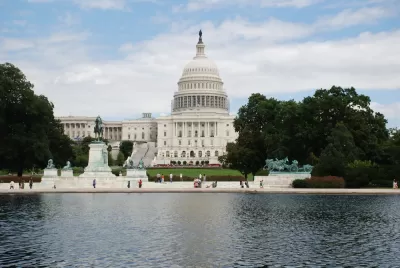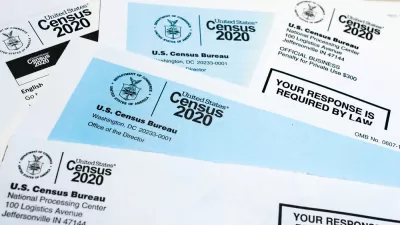A reapportionment of House of Representatives will begin when the results of the Census 2020 have been finalized. A new analysis indicates that ten House seats will likely shift from the Northeast and Midwest to the West and South.

The U.S. population estimate for the year ending July 1, 2019, released by the U.S. Census Bureau on December 30, showed the slowest growth in a century. The Washington Post editorial board indicated that the "U.S. population grew only 6.7 percent in the past decade, which is the slowest 10-year rate since the census began in 1790."
However, that slow growth was far from uniform, and soon the nation's 435 congressional districts, with most currently representing approximately 747,000 people, will be reapportioned among the states to reflect population changes determined by Census 2020. That also means the Electoral College will be reshaped as well.
"The latest [Census] numbers, released Monday [Dec. 30], represent the final estimates from the government before next year's decennial Census, which will determine how many House seats and Electoral College votes each state will have for the next decade," writes Ally Mutnick, a campaign reporter for POLITICO. "That reapportionment, expected in December 2020, will kick off the year-and-a-half-long process of redrawing congressional-district maps..."
According to projections from Election Data Services, a political consulting firm that specializes in redistricting, 17 states are slated to see changes to the sizes of their delegations, including 10 that are forecast to lose a seat beginning in 2022.
From the report [pdf] :
California -1 (from 53 to 52)
Kimball Brace, President of Election Data Services, Inc. cautioned users that even though there is a very short time before the Census, the population projections are still subject to change.
Bucking the trend
Three state states don't fit the geographic pattern of winners and losers: one in the West and two in the South; each will lose one congressional seat.
"While California will continue to send the largest delegation of any state to Capitol Hill, its political haircut is a consequence of more and more people moving elsewhere around the country," reports Bay Area News Group's Casey Tolan. "Many of them are pushed out by the state’s sky-high housing prices and cost of living, experts say."
“What you’re seeing is a continuation of the trend that’s been happening from the 1930’s: people leaving the Northeast and Upper Midwest and going south and west,” said Brace. “But California is the exception.”
California did not lose population during the year, though there is a huge difference between the Census Bureau and the state Department of Finance as to how much it grew from July 2018 to July 2019. The Census estimated it at 50,635 while the state set it at over 141,000 people. Two other western states, Alaska and Hawaii, actually lost population, but they will not see a loss of representation, though the former only has an at-large representative.
It’s too early to predict which parts of California are most likely to lose a representative. The census will take place this year, with results released by April 2021. Then the state’s citizens redistricting commission will crunch the numbers to draw new lines for congressional and legislative districts, finishing their work by August 2021, in time for the 2022 elections.
According to the EDS report, California's loss of one congressional seat will be Montana's gain, which will go from having one at-large seat to two congressional districts.
Another state bucking the trend is Alabama, which stands to lose one Congressional seat, reports Caroline Klapp for WAFF (TV) of Huntsville, Alabama, on Jan. 7.
Right now Alabama is at risk of losing a congressional seat, based on early estimates. And Alabama is the only state in the south in that position. Make no mistake, Alabama is growing, but other states are growing at a faster rate and have higher census participation.
Actually West Virginia is considered a southern state as well, though not the Deep South. Unlike Alabama and California, the Mountain State has lost population for the last few years, part of "a long-running trend," according to one expert, so the loss of the seat was projected years ago.
The Census estimated that two other southern states lost population: Louisiana and Mississippi, though neither is at risk of losing a congressional district.
As noted in the report's projections above, Florida and Texas will see the largest gains, with two and three new congressional districts, and therefore electoral votes, respectively.
Related in Planetizen:
FULL STORY: Epic redistricting battles loom in states poised to gain, lose House seats

Alabama: Trump Terminates Settlements for Black Communities Harmed By Raw Sewage
Trump deemed the landmark civil rights agreement “illegal DEI and environmental justice policy.”

Study: Maui’s Plan to Convert Vacation Rentals to Long-Term Housing Could Cause Nearly $1 Billion Economic Loss
The plan would reduce visitor accommodation by 25% resulting in 1,900 jobs lost.

Planetizen Federal Action Tracker
A weekly monitor of how Trump’s orders and actions are impacting planners and planning in America.

Waymo Gets Permission to Map SF’s Market Street
If allowed to operate on the traffic-restricted street, Waymo’s autonomous taxis would have a leg up over ride-hailing competitors — and counter the city’s efforts to grow bike and pedestrian on the thoroughfare.

Parklet Symposium Highlights the Success of Shared Spaces
Parklets got a boost during the Covid-19 pandemic, when the concept was translated to outdoor dining programs that offered restaurants a lifeline during the shutdown.

Federal Homelessness Agency Places Entire Staff on Leave
The U.S. Interagency Council on Homelessness is the only federal agency dedicated to preventing and ending homelessness.
Urban Design for Planners 1: Software Tools
This six-course series explores essential urban design concepts using open source software and equips planners with the tools they need to participate fully in the urban design process.
Planning for Universal Design
Learn the tools for implementing Universal Design in planning regulations.
Caltrans
Smith Gee Studio
Institute for Housing and Urban Development Studies (IHS)
City of Grandview
Harvard GSD Executive Education
Toledo-Lucas County Plan Commissions
Salt Lake City
NYU Wagner Graduate School of Public Service





























